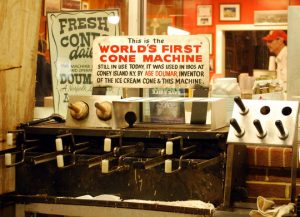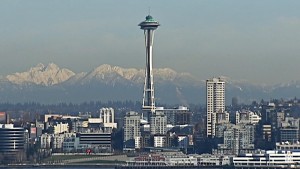world’s Fair
 Sometimes, an accident can be a good thing. In the late 1800s and early 1900s, ice cream prices dropped and the creamy dessert quickly became a more popular treat. Ice cream street vendors popped up across the United States and in Europe. The vendors quickly began competing over more than just flavors, but to what they put the ice cream in. You wouldn’t think it would really matter what you put the ice cream in…as long as you ended up putting it in your mouth eventually, but at that time, the container was somehow of great importance.
Sometimes, an accident can be a good thing. In the late 1800s and early 1900s, ice cream prices dropped and the creamy dessert quickly became a more popular treat. Ice cream street vendors popped up across the United States and in Europe. The vendors quickly began competing over more than just flavors, but to what they put the ice cream in. You wouldn’t think it would really matter what you put the ice cream in…as long as you ended up putting it in your mouth eventually, but at that time, the container was somehow of great importance.
Vendors tried to make their ice cream the most interesting, because after all, presentation is everything. Paper, glass, and metal were common materials used for holding ice cream. Then came the not-so-sanitary “penny licks.” Many vendors would scoop their flavor of the day into a glass and hungry buyers would pay a penny to lick the glass clean before returning it to the vendor. Not only was this not the cleanest way to eat dessert, but also customers kept breaking the glass or “accidentally” walking away with them.
The inventor of the actual ice cream cone, called a “cornet,” still remains a mystery. But, everyone agrees that the cone-shaped edible ice cream holder invention, was definitely an accident. In 1902, Antonio Valvona filed the first patent in Britain for an edible ice cream cup. The second came from Italo Marchiony, an Italian immigrant living in New York. However, these patents covered bowls, not cones. So where did the cone-shaped ice cream holder come from? Historians agree on where and when, just not who.
The 1904 World’s Fair in Saint Louis celebrated the centennial of the Louisiana Purchase, although it was one year late. There was an abundance of food, and more than 50 ice cream vendors, as well as over a dozen waffle stands. With the heat, ice cream was the top seller, but not too many people wanted hot waffles. Nevertheless, the waffles proved useful when all the ice cream vendors ran out of cups. The generally accepted  story goes likes this: “ice cream vendor Arnold Fornachou couldn’t keep up with demand and ran out of paper dishes. Ernest Hamwi, a vendor next to Mr Fornachou sold zalabia, a waffle-like pastry. Because his zalabia wasn’t selling, Mr Hamwi decided to help his neighbor by rolling up one of his waffle pastries and giving it to Fornachou who put ice cream in it. Viola, the first ice cream cone sold.” The other vendors got in on the idea as well, each claiming that it invented the idea. With all the hustle and bustle of the World’s Fair, no one really knows who invented the cone first. Many patents were filed after the fair for “waffle-rolling” machines, and many people still take the credit for this accidental invention.
story goes likes this: “ice cream vendor Arnold Fornachou couldn’t keep up with demand and ran out of paper dishes. Ernest Hamwi, a vendor next to Mr Fornachou sold zalabia, a waffle-like pastry. Because his zalabia wasn’t selling, Mr Hamwi decided to help his neighbor by rolling up one of his waffle pastries and giving it to Fornachou who put ice cream in it. Viola, the first ice cream cone sold.” The other vendors got in on the idea as well, each claiming that it invented the idea. With all the hustle and bustle of the World’s Fair, no one really knows who invented the cone first. Many patents were filed after the fair for “waffle-rolling” machines, and many people still take the credit for this accidental invention.
 We have all heard of the World’s Fair, and I think most of us know about the big push between nations to have it held in their country. After World War II, the United States didn’t get to host the World’s Fair until April 21, 1962. I think that most of us knows of the Seattle Space Needle, and I think that most adults know that it was a part of the World’s Fair, also known as the Century 21 Exposition. The fair ran from April 21, 1962 to October 21, 1962, in Seattle, Washington, of course.
We have all heard of the World’s Fair, and I think most of us know about the big push between nations to have it held in their country. After World War II, the United States didn’t get to host the World’s Fair until April 21, 1962. I think that most of us knows of the Seattle Space Needle, and I think that most adults know that it was a part of the World’s Fair, also known as the Century 21 Exposition. The fair ran from April 21, 1962 to October 21, 1962, in Seattle, Washington, of course.
Nearly 10 million people attended the fair in Seattle that year. So many World’s Fairs did not make a profit, but unlike the other world’s fairs of that era, Century 21 did make a profit. After the expedition, Seattle  was left with a fairground and many public buildings and public works. It really revitalized Seattle’s economic and cultural life. The Space Needle was built there, of course, and the Alweg monorail, as well as several sports venues…Washington State Coliseum, now Key Arena and performing arts buildings…the Playhouse, now the Cornish Playhouse. Many of these have been remodeled or replaced now, but the whole area started around the World’s Fair. The Space Needle was built to withstand wind speeds of 200 mph, double the requirements in the building code of 1962. An earthquake registering 6.8 on the Richter scale jolted the Needle enough in 2001 for water to slosh out of the toilets in the restrooms. The Space Needle will not sustain serious
was left with a fairground and many public buildings and public works. It really revitalized Seattle’s economic and cultural life. The Space Needle was built there, of course, and the Alweg monorail, as well as several sports venues…Washington State Coliseum, now Key Arena and performing arts buildings…the Playhouse, now the Cornish Playhouse. Many of these have been remodeled or replaced now, but the whole area started around the World’s Fair. The Space Needle was built to withstand wind speeds of 200 mph, double the requirements in the building code of 1962. An earthquake registering 6.8 on the Richter scale jolted the Needle enough in 2001 for water to slosh out of the toilets in the restrooms. The Space Needle will not sustain serious  structural damage during earthquakes of magnitudes below 9. I think it is an amazing structure.
structural damage during earthquakes of magnitudes below 9. I think it is an amazing structure.
Since my daughter, Amy Royce and her family have moved to northern Washington, we have had the opportunity to visit the area and the Space Needle. I had been there before, but my husband, Bob had not. It doesn’t matter how many times you go up in the Space Needle, because each time is spectacular. The view is amazing, and since you can walk all the way around it, you have a different view on each side. The area is beautiful to be sure. I don’t know how often Amy and her family will get down there, now that they have moved to the Bellingham/Ferndale area, but I don’t think I would live that close without taking a trip to see a little bit of history once in a while.

